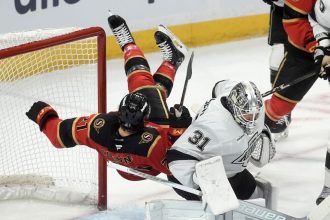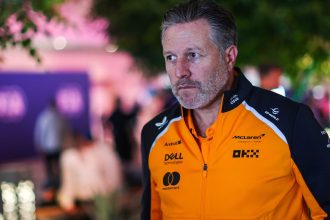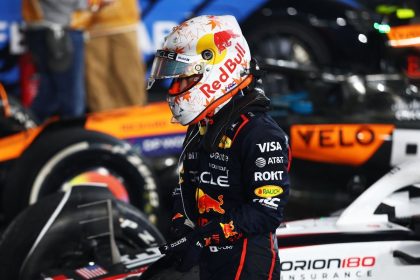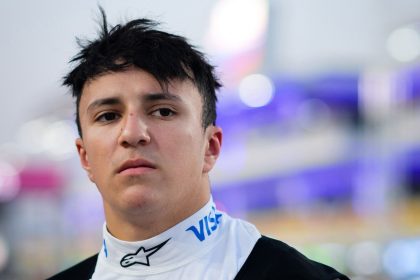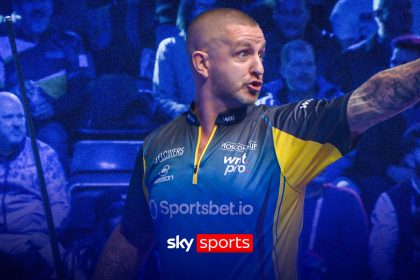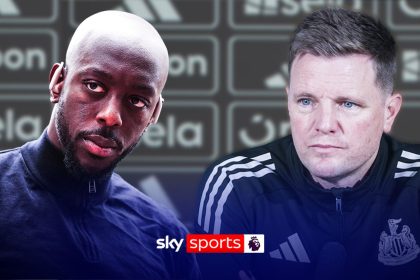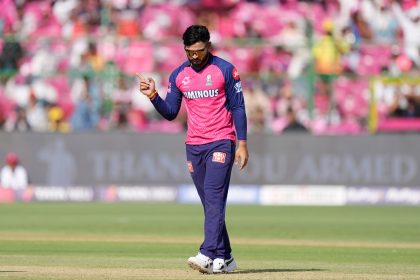Sunday when the cars roll off the line for the start of the 109th running of the Indianapolis 500, Arrow McLaren driver Christian Lundgaard will be in somewhat unfamiliar territory.
Starting inside the Top 10 at the biggest spectacle in motorsports.
After three seasons spent sweating out whether he would even make it into the field, Lundgaard was one of the fastest 12 cars during the Full-Field Qualifying session, Lundgaard was in the Fast 12 for the first time in his IndyCar career.
After what he called a “stressful” Saturday, that experience of his first Fast 12 was to him, the “least stressful” day of the weekend.
“I feel like the Fast 12 was the least stressful day,” Lundgaard explained to me when I asked him about the experience.
The reason? Saturday’s qualifying session at the Indianapolis 500 is as stressful as it gets in the sport. Lundgaard began by highlighting accidents that happened earlier in the day, first with Marcus Armstrong in practice and then with Colton Herta during his first qualifying run, outlining just how quickly it can go wrong for you, and your entire team.
“I think Saturday qualifying is much, much more stressful, and I think we see it for the reason of what happened to Colton, and Marcus Armstrong. The amount of work that goes into this one car just for the 500 from the team’s perspective, it’s a year’s worth of preparation that goes in, that can be ruined in a split second,” described Lundgaard.
“And then you suddenly have to rebuild a car that is not going to have all the items, like all the speedway fun, special items that go on the car and all the small little tweaks and fine-tuning. And you crash in your first run in qualifying, and then you’re watching everybody else go out there and put laps and speeds on the chart, and you’re just waiting and hoping that you actually will just go out again, and you don’t know what the car is going to feel like.
“Obviously for me that wasn’t the case. Touch some wood, hopefully it doesn’t, right?”
It was at that moment Lundgaard leaned forward and knocked on the table in front of him, emphasizing the point.
The stress picked up a notch at the end of the Full-Field Qualifying. Conor Daly took to the track for the final run of the day, with Lundgaard sitting in P12. One good run from Daly would have knocked Lundgaard out of the Fast 12, leaving him on the outside looking in on Sunday.
“I felt like that was very stressful because Conor’s last run, the last run of the day, he was on track to beat us. And he made a mistake in 1 and 2 that cost him,” added Lundgaard. “I didn’t know how to react because this is not a situation that I’ve been in. I’ve been in something very similar, but that was fighting to just be in the race, you know, like at least now I had the peace of mind knowing that I was in the race regardless. And it’s stressful.
“It’s … it’s not fun.”
Lundgaard even woke up feeling stressed Saturday morning.
“Waking up Saturday morning, I was kind of just shaky, in a sense, because I felt like I was much more nervous this year than I’d been prior, just because I felt like I at least had a chance to do something, where prior I don’t even know if I’m going to be in the race.
“So that was definitely a different kind of feeling.”
That is the stress of the world’s biggest sporting event, and what it can do to the drivers who are putting it all on the line every lap.
SB Nation caught up with Lundgaard ahead of the 109th Indianapolis 500 to talk about his first year at Arrow McLaren, what it takes to get it right at Indianapolis Motor Speedway, and his chances in the 500.
His Indianapolis 500 so far
Lundgaard told me it had been a “good month” in Indianapolis so far. In addition to qualifying eighth for the 109th Indianapolis 500, he also finished second in the race at Barber in Alabama to open the month, his third consecutive podium finish.
Still, as he reminded me, every day at IMS can be different, and even the good months have their share of ups and downs.
“It’s been a good, good month so far. I think there’s been ups and downs for sure. I think that’s the story every year you come to the Speedway. You have a good day, you have a bad day,” said Lundgaard.
What has made this year a more pleasant experience for him, is the fact that he has a chance to be in the fight on Sunday. In his first three Indianapolis 500 experiences, his best starting place was P28, and his best finish was 13th.
Both of those results came last season.
“It’s a much more pleasant and fun experience this year than what I have been a part of prior, and I get to enjoy it much more. You don’t really enjoy showing up for a race weekend, as big as this is — it’s more than just a weekend — you’re not enjoying it if you’re not in the fight,” described the Arrow McLaren driver.
“If you’re just fighting to be in the race, it’s just more stressful than anything else. And I definitely have felt like I’ve experienced a different kind of stress, and just how different it is fighting for, I wouldn’t really go to the extent of saying fighting for pole, but at least fighting for the front end of the field, and making sure that you’re well positioned for the start of the race,” added Lundgaard. “It’s, just been a much more pleasant experience and the team’s done an awesome job.”
Lundgaard credited his team with helping him get a better understanding of the No. 7, as well as the track itself.
“I think it’s helping me to understand how to drive this car, but also, doing it on the go, feeling what’s so different from the prior muscle memories and all my other experiences,” added Lundgaard.
All of this adds up to him and the team having a chance on Sunday.
“Obviously having a car in the front row [Pato O’Ward, who starts third], we’re eighth, and then Kyle [Larson] and Nolan [Siegel] a little further back, but I feel like we’ve done a tremendous job and the cars are fast and very trim and we’re in it, so we do have a chance to win.”
Getting it right at IMS
Having a chance to win the Indianapolis 500 is one thing.
Getting it all right, even just over one lap at IMS, is another.
Every driver I’ve talked to has discussed at length how tough it is just to get one lap right at Indianapolis Motor Speedway. But getting all the laps right over all the time the drivers have in the cars before the race itself begins?
That is almost impossible.
“You don’t,” replied Lundgaard when I asked him how hard it is to balance all the time they have in the cars before the race.
“I think that’s what’s so tough. You have so much time in the car and it’s almost too much, right? It’s very easy to get lost,” added the driver. “It’s very easy to go down the wrong path because the weather changes, the conditions change, the car feels really good in cold conditions, and it feels terrible in hot conditions or vice versa, and it’s kind of finding that balance of what does the car need for certain conditions from to keep that feel that you have, right?”
Then comes balancing the different sessions. When the drivers arrive in Indianapolis ahead of the 500, the early focus is on the race pace. But then as qualifying approaches, the focus turns to preparing for the four-lap runs where speed is everything.
But then, the focus shifts again.
“That’s what’s so tough, when you’re doing [from] Tuesday up until Thursday practice before qualifying, you’re focused on the race car. And then Fast Friday is pure quali trim. But at the end of the day, you also want to keep the car in one piece, so you don’t really want to run that much, where the conditions might have been completely different Tuesday to Thursday, than what you’re going to see on race day,” described Lundgaard. “Monday practice, after qualifying, was much closer to what is anticipated for race day and the car was behaving in a completely different way.”
That, described Lundgaard, is just part of what makes Indy so “difficult” for the drivers.
“That’s just what’s so difficult because at the same time, conditions are changing, you’re making changes to the car or you’re keeping the exact same car that you had, I guess four days before qualifying weekend and it just doesn’t feel the same,” added the driver. “And it’s just so mind-blowingly different, and it’s just very difficult to keep track of.”
Then there is the fact that every turn, and every bit of the track, is different. When I asked the Arrow McLaren driver about that factor, he brought up the wind as an example.
“The entire week of practice, Fast Friday, Saturday qualifying, was one wind direction,” started Lundgaard. “We show up Sunday and it’s the opposite way, and it’s the opposite way again on Monday, and something we haven’t experienced. And it’s just so difficult because you build up all these references Tuesday, Wednesday, Thursday, Friday, Saturday, OK, it’s all the same. Then you go out Sunday and the wind is so much less, and it’s a little bit of a wind direction shift.
“And you’re like, ‘OK, how do I adjust to that?’
“Because all my references are with the balance like this.”
Lundgaard posited that those changes, and drivers trying to adjust to them, could be a reason for some of the crashes we’ve already seen at Indianapolis this year.
“And I think we’ve seen that with a few people, making mistakes and brushing the wall or having big crashes and I think that’s what caught Scott [McLaughlin] out too in in in Sunday morning practice, the track was completely different.
“It was a lot cooler than the day before and, yeah, it’s not fun.”
Thankfully, Lundgaard has an entire team behind him helping the driver sort it all out.
“I think as a team, Arrow McLaren has helped me a lot with just understanding and keeping the mentality, and just keeping calm and staying in the present, and also keeping the vision of what’s really important for the long term versus just, ‘[T]his is what [the track] feels like this right now, and we have a lot of references from times where things have felt good, or this was similar to what we were expecting on race day.”
What can be fun, however?
When you do hook the car up for a lap at IMS.
I asked Lundgaard what the track feels like at qualifying speeds, and he gave me both the best-case scenario, as well as the worst-case scenario.
Let’s start with the worst-case scenario.
“If you’re out there and something doesn’t feel right, it is the worst time of your life because you feel like everything you’re doing is out of your control,” started Lundgaard. “I think sometimes in traffic running, you don’t know what to expect because cars are running different lines. There’s people fighting ahead of you, behind you.”
But the best case? Lundgaard’s eyes lit up when he walked me through this part of the answer.
“I would definitely say when everything is clicking and you’re just driving around out there enjoying yourself, it is the most fun you’ll ever have,” began Lundgaard.
He then offered a comparison I was not quite ready for, but understood immediately.
“It is the best feeling when everything clicks. When everything clicks it’s, it’s kind of I don’t know if you’ve seen the video of Charles Leclerc’s sunset lap at Austin a couple of years ago, that’s like the perfect description of how it feels, because it’s just so picture-perfect,” continued Lundgaard. “And it almost gives me goosebumps just talking about it right now because you’re kind of getting that blink of a thought, of a vision, of what it really feels like.
“And it’s it’s awesome.”
Year 1 at Arrow McLaren
Something else that is awesome?
Lundgaard’s start to the 2025 season, and his transition to Arrow McLaren.
After four years at Rahal Letterman Lanigan Racing, where his best place in the standings was an eighth-place finish during the 2023 IndyCar season, Lundgaard moved to Arrow McLaren for the 2025 campaign. Thanks to the three podiums he already has this year, Lundgaard enters the Indianapolis 500 sitting third in the standings, behind only Alex Palou and teammate Pato O’Ward.
When it came time to ask some questions from readers, the first one touched on how quickly — and how well — Lundgaard was able to adjust to life at Arrow McLaren and fit in with the team, to produce these results.
“I think it’s a very simple, short answer really. I don’t want to sound cocky, right? I know what I’m capable of doing, and I think if you put a fast driver in a fast race car, the results will come by themselves,” started Lundgaard. “Obviously, the whole package needs to fit. If you put a fast driver in a fast car, you’re going to have good results, but you’re not going to see them consistently, right? And I think that’s where the No. 7 crew has done an incredible job.”
Lundgaard then highlighted the importance of communication in a race team, and “speaking the same language” when it comes to the situations that arise.
“We spent a lot of time in the offseason preparing and making sure we were speaking the same language, and kind of covering all bases, covering all kinds of situations, making sure when I was saying, ‘hey, Chris,’ my engineer [Chris Lawrence] would understand what I’m trying to tell him,” continued Lundgaard. “I think the more time you spend with someone, the more you’re gonna learn about them, and I feel like we did a good job with that.”
Racing in the digital media era is more than just going fast on the track. It is also connecting with the fans off the track, and social media goes a long way in that effort.
Arrow McLaren does a tremendous job on social media, as do the drivers. One reader did want to know, however, if Lundgaard felt like he was stepping into the “adult in the room” role vacated by Alexander Rossi when creating content with O’Ward and the rookie Siegel.
“That’s a good one. I hadn’t really thought about that,” started Lundgaard.
“Funnily enough, Pato is the oldest of the team, Nolan’s definitely the youngest, I think,” continued the Arrow McLaren driver. We have a good variety of personalities, right? I think Pato is very outgoing, explosive. I think Nolan is a little more up-and-coming young kid that is just kind of trying to explore.”
Lundgaard then reflected on his journey for a moment. Born in Denmark, he began karting professionally when he was just 11 years old, competing all over Europe, and he got his start in the lower single-seater formulae when he was just 15.
As he described it, you grow up fast in that world.
“Obviously, I grew up at a certain age, right, but I got into this motor racing industry at a very young age, and I was kind of left by myself. I started traveling by myself when I was 13, so basically ten years ago now.
“And you grow up really fast.
“You mature extremely fast. And I was on the road through my high school years and, basically what’s equivalent to college, back home and every time I would come home to school, I’d be like, ‘[W]hat are you guys doing?’ You grow up in a sense,” described Lundgaard.
“I think that’s just because I was surrounded by much older people, you know, working with people that are twice my age back then, and you just grow up so fast,” continued the driver. “When I now see myself with Pato, with Nolan, when we’re doing all this stuff, I’m just gonna be myself.
“I’m not gonna try to put up this character, that sometimes I feel like it looks like Pato’s doing that, but that’s just who he is. And I think it’s becoming more apparent to people that that’s just who he is.
“I mean, he’s awesome.
“I love Pato. He says what’s on his mind.”
His chances in the 500
As our time wound down, we circled back to this year’s Indianapolis 500. Having spoken with both Siegel and O’Ward about their Indy-specific liveries, I wanted to get Lundgaard’s thoughts on his bespoke design for the 109th Indianapolis 500.
He began with a rather funny memory of when Arrow McLaren introduced their designs for the 2025 season, with the “Never Stop Racing” motto they are using throughout the entire McLaren organization.
“Yeah, I never stop racing, the whole McLaren concept. Here, we keep laughing, calling it ‘Nolan Siegel Racing.’ NSR. When we saw the renderings for the first time, we were like, ‘I didn’t know this was Nolan’s team.’
“So we had a good laugh about that.”
We then turned to the design of the No. 7 car for the Indianapolis 500:
Arrow McLaren
“You’re never gonna get tired of white. It’s always classy, and it always looks awesome.”
Lundgaard is also a fan of his full-season car, as well as all the team’s cars.
“I think my general season car is probably the prettiest car on the entire grid,” added the driver. “I feel like we have kind the best-looking cars.”
Our time was nearly up, so I did have one final question.
What would a win in the 500 mean for him?
“It’s a good question,” began Lundgaard.
“I would say I’m more relaxed. I’m more kind of laid back and don’t really think about it, because at the end of the day, I know it’s going to be life-changing. I’ve always been very good at not setting expectations and, I look at it realistically.
“But winning would obviously, I think it would be more of a surprise than anything else. Obviously, I know I’m good enough to win. The question is: Is it going to be my time? Is it going to be my day, on the very given day?
“I think that’s the big question,” continued Lundgaard. “I’m gonna take it in and take it as it comes, and enjoy the moments.”
However, if he does win the Indianapolis 500, he knows that the next few days will be “hell,” as he put it.
But he will have a great mentor by his side helping him through it, should that need arise.
“I know that the following days are gonna be hell [should he win on Sunday], having to go to New York, having to do all these media appearances, and then going straight to Detroit [for the next race] and, be back on it, switched on,” added Lundgaard. “I think from my own perspective, I don’t really want to think about what it’s going to bring, what it’s going to do.
That is where Tony Kanaan, Arrow McLaren’s Team Principal and the winner of the 2013 Indianapolis 500, would come in.
“I’ve heard more stories than I can count to from Tony Kanaan about what it does, winning the 500, and I think he’s more proud of it than he’s not.
“I think that’s very, very obvious and Tony’s a great guy and he’s given me a lot of tips and help, just from how to approach [racing] over the weekends and all of this stuff.
“So if I’m ever in doubt, I’ll just ask Tony.”


